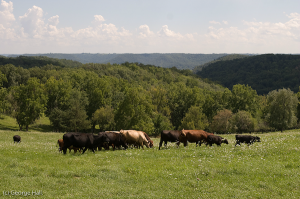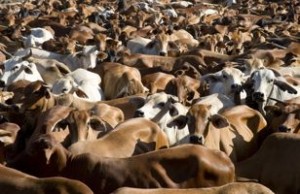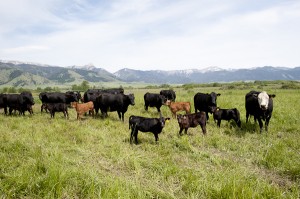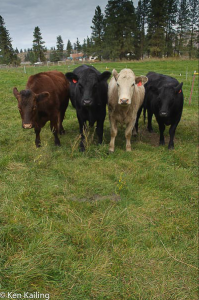I thought all cows ate grass…
If asked, most people could not tell you where the meat on their plate came from. In fact, if they wanted to know, it would be darned difficult – if not impossible – to find out. on the other hand, while imagining that the beef cow they will be eating is frolicking on lush green pastures, the average American today does NOT want to meet their dinner while it is still standing.
No, Virginia, not all cows eat grass. That lovely image of a herd of cattle happily munching away and contentedly chewing their cud is mostly a figment of your imagination.
Over the last 70 years, the beef industry has evolved into an intense, industrial enterprise designed to put as much weight on animals as fast as possible and get the resulting meat to market as quickly as possible.
To do that, beef cattle – who are by nature ruminants (grass eaters) – are hustled off the pasture where they spent their first six months of life to spend the next six to eight months packed into confined animal feeding operations (CAFOs) with no green pasture in sight. In those feedlots, they are fed grain – lost of grain – to bring them up to the target weight for slaughter. Since it takes as much as 7 pounds of grain (corn, barley, soybeans, and other grain) to develop a pound of meat and those cattle gain about 3 pounds a day, that’s a lot of feed.
At the same time, to keep the cattle gaining weight, they are given growth hormones and antibiotics. According to the Union of Concerned Scientists, 70% of all antibiotics used in the United States are fed to livestock. And, as many as six different growth hormones may be given to beef cattle, three of which occur naturally and three of which are synthetic.(1)
Since those animals are eating 50 to 60 pounds of feed a day, a quick look at the source of that feed is important. Forty-four percent of the corn grown in the US is used for animal feed, and 86% of the corn planted in 2010 was bio-engineered varieties that contained insect- or herbicide-resistant genes (or both). Fifty-nine percent of the soybean harvest is crushed for oil, however the meal left over from the crush is used as animal feed. A whopping 94% of all soybeans grown are genetically engineered to be herbicide tolerant.
Meat and potatoes, please…
Researchers have linked serious health problems such as heart disease, stroke, diabetes, and certain types of cancer to heavy meat consumption. Americans eat more meat than ever before, and most of it is high in saturated fats.
We consume about 67 pounds of beef a year for each person – man, woman, and child. And those animals eat a lot of corn and other grain: most beef cattle are “finished” on grain before slaughter; only a very small percentage is entirely “grass-fed.”(2)
Ah, back to that question – don’t cows eat grass? More and more farmers and ranchers are raising grass-fed beef on a natural diet consisting of fresh grasses, legumes, and other plants and allowing them to roam about.
Many are choosing to follow organic practices in their herd management, which are clearly healthier and more humane for the animals. The good news is that meat from those animals is free of antibiotics, steroids, hormones, pesticides, herbicides and other potentially toxic substances. The bad news is that it can take nearly two years to bring those animals to market on grass.
Studies have shown that an animal’s diet can have an impact on the nutritional content of the meat on the consumer’s table. Grass-fed meat has been shown to contain less fat, more beneficial fatty acids, and more vitamins and to be a good source of a variety of nutrients. According to a study published in the Journal of Animal Science in 2009, eating grass-fed beef provides many benefits to consumers(3):
- Lower in total fat
- Higher in beta-carotene
- Higher in vitamin E (alpha-tocopherol)
- Higher in the B-vitamins thiamin and riboflavin
- Higher in the minerals calcium, magnesium, and potassium
- Higher in total omega-3s
- A healthier ratio of omega-6 to omega-3 fatty acids (1.65 vs 4.84)
- Higher in CLA (cis-9 trans-11), a potential cancer fighter
- Higher in vaccenic acid (which can be transformed into CLA)
- Lower in the saturated fats linked with heart disease
Lower Fat – Meat from grass-fed cattle is much lower in fat, and therefore lower in calories. A 6-ounce steak from a grass-finished animal has almost 100 fewer calories than the same sized-piece from a grain-fed animal. If, like the average American, you eat about 67 pounds of beef a year, switch to grass-fed beef and you’ll save nearly 18,000 calories a year.
Omega-3 Fatty Acids – Omega-3 fatty acids are fats that are essential to human health. Sixty percent of the fatty acids in grass is omega-3, which is formed in the chloroplasts of green leaves. Grass-fed cattle can contain as much as two-to-four times more omega-3 fatty acids than grain-fed animals.
At the same time, a high ratio of omega-6 to omega-3 fatty acids has been linked with an increased risk of cancer, cardiovascular disease, allergies, depression, obesity, and autoimmune disorders. A ratio of four to one or lower is considered ideal, Grain-fed beef has a much higher ratio of omega-6 to omega-3 fatty acids than wild game or grass-fed beef. In grass-fed beef the ratio is approximately 2 to 1, while the ratio in grain-fed beef is more than 14 to 1.
More Vitamins – In humans vitamin E is linked with la lower risk of heart disease and cancer. Meat from grass-fed cattle is higher in vitamin E.; as much as four times higher in vitamin E than meat from feedlot cattle.(4)
Rich source of CLA – Meat from grass-fed animals is the richest known source of “conjugated linoleic acid” or CLA. Grass-fed cattle have been found to produce 2 to 5 times more CLA than cattle fed high grain feedlot diets. In laboratory animals, a diet containing even a small amount of CLA greatly reduced cancerous growths.
More to Come
Over the next couple of weeks we will be looking at meat – particularly beef – as part of our diets, our culture, our economy, and our environment. Where does your meat come from? Do you really know?
________________________________________
Resources:
(1) Union of Concerned Scientists, http://www.ucsusa.org/food_and_agriculture/solutions/wise_antibiotics/pamta.html
(2) Farm Animal Statistics, http://www.humanesociety.org/news/resources/research/stats_meat_consumption.html
(3) S.K. Duckett et al, Journal of Animal Science, (published online) June 2009, “Effects of winter stocker growth rate and finishing system on: III. Tissue proximate, fatty acid, vitamin and cholesterol content.”
(4) Dietary supplementation of vitamin E to cattle to improve shelf life and case life of beef for domestic and international markets. G.C. Smith, Colorado State University, http://www.animalfeedscience.com/article/0377-8401%2895%2900901-9/abstract
'庫間 > 해외자료' 카테고리의 다른 글
| 유기농 실험이 중국 농촌에 활력을 가져오다 (0) | 2012.02.11 |
|---|---|
| 유전자조작 작물의 증가를 요구하는 업계에 경종을 울리는 운동가 (0) | 2012.02.11 |
| 식량과 기후변화 (0) | 2012.02.02 |
| 중동 지역의 옥상텃밭 (0) | 2012.01.31 |
| 자선은 정의의 적이다 (0) | 2012.01.30 |



